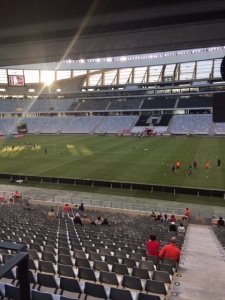On February 8, the the class attended a football match at Cape Town Stadium at 20:00. The match was a part of the ABSA Premiership League that involved Ajax Cape Town and Bloem Celtic. Unlike in American soccer, fans at South African matches are extremely passionate about their respective teams. Miles, our bus driver for our time in Cape Town, dropped us off at the entrance of the stadium and we proceeded to walk towards the ticket gate. Every where we looked there were fans dressed mostly in red—the colors of the Ajax. Scattered amongst the red were a few pockets of fans wearing green to support Celtic. After getting our tickets checked we were given a quick pat-down by security and were free to enter the stadium.
Our seats were located in the lower tier of the red area overlooking the midfield line. Even though we were early for the game, the energy was electric. A group of fans walked in with band instruments like trumpets, trombones and drums and waved a large Ajax flag. Vendors, perhaps sensing we are only in Cape Town for a visit put on a show as they tried to sell goods. Some made rhymes and used references to American culture in an attempt to relate more closely to the group. As kick of inched closer, the aforementioned band began to loudly play fights songs and chant. The teams were then announced and handshakes were exchanged, allowing for the game to begin.
Now, earlier on in our experience we visited a Jewish Museum which highlighted what Jewish individuals in Cape Town lived through and achieved. Our guide, Mr. Kavin, walked with myself and a few classmates for a large portion of the exhibit. Naturally, we started to pick his brain about the country and mentioned that our research before arriving focused on the representation of black athletes in the United States vs South Africa. Mr. Kavin, full of opinions and wisdom, said that almost no white people in South Africa play soccer anymore. At first I was skeptical, however, attending the soccer game provided value evidence to support his statement.
As the two teams took their sides, we scanned the field, placing bets amongst one another about who would score the first goal. While looking at the numbers on their backs, it became clear that a strong majority of the athletes were black. Except for one, the white goalie for Ajax. Now what Mr. Kavin said made sense, the wealthier white athletes stick to playing rugby or cricket, which require more gear and investment. While inversely, black athletes, whom often come from more impoverished regions play soccer because the amount of monetary investment for equipment is much lower.
Perhaps also, soccer for black athletes is a way to create a community in the post-apartheid era in South Africa. In a reading titled “The Natives Land Act of 1913 and its legacy” by Alan Dodson states:
“Awaking on Friday morning June 20, 1913, the South African native found himself, not actually a slave, but a pariah in the land of his birth.”
To understand this potential coincidence, it is important to realize that blacks have been mistreated by whites for many years. Due to this, they often turned to athletics as a way to pass the time, both recreationally and professionally. As an athlete, sports have always been a way to release my energy, communicate with friends and express myself. However, for black South African athletes, the sport is a way to cope with the past.
It is hard to find a sport in the United States that functions in the same way as football does in South Africa. Perhaps the only is basketball, where again, a majority of the players are black. Growing up in a basketball family, I have been to many tournaments, played in many games and still follow until this day. Looking even deeper into the sport, street ball tells the tale of the family vibe that is provided by sport. Each game is played with an intense passion, blood is shed, players yell at one another, but at the end of the day they are family. They un-lace their shoes, shake hands and go about their day. In fact, the game helps to bolster their culture and create a stronger sense of family. It provides an escape for many from life on the streets and could even open doors to a professional.
After the game it became clear that South African football is much like basketball in the United States. Sport creates a sense of structure in young individual’s lives, practice makes you work, games make you face adversity and injuries make you cope with an issue. All of these lessons can be linked to real life scenarios, which is why athletes are some of the most dedicated people in the world. This is even more important in a country like South Africa because apartheid structure still stands although it has been abolished. The game of football can open many doors, and black athletes from poor economic backgrounds realize this. Hopefully, whites can step back into the game of football and help even further unite the country and lead it into prosperity.
Although this experience has opened my eyes and created a connection between South African and American sports. However, one question still sticks in my mind: how can South Africa get more white athletes involved in football again, in order to help the country completely recover in the post apartheid era?
Cape Town Stadium: Ajax vs. Celtic

